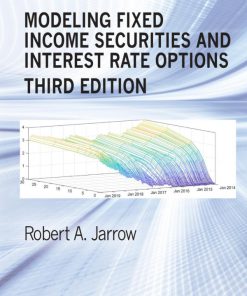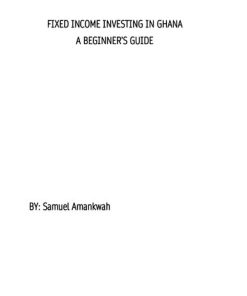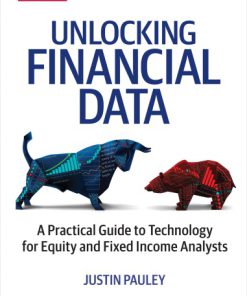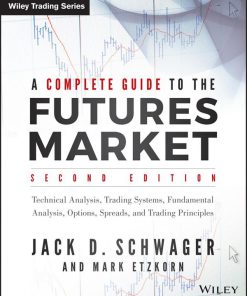Fixed Income Trading and Risk Management The Complete Guide 1st Edition by Alexander During ISBN 1119756359 9781119756354
$50.00 Original price was: $50.00.$25.00Current price is: $25.00.
Fixed Income Trading and Risk Management The Complete Guide 1st Edition by Alexander Düring – Ebook PDF Instant Download/Delivery: 1119756359, 978-1119756354
Full dowload Fixed Income Trading and Risk Management The Complete Guide 1st Edition after payment

Product details:
ISBN 10: 1119756359
ISBN 13: 978-1119756354
Author: Alexander Düring
A unique, authoritative, and comprehensive treatment of fixed income markets
Fixed Income Trading and Risk Management: The Complete Guide delivers a comprehensive and innovative exposition of fixed income markets. Written by European Central Bank portfolio manager Alexander During, this book takes a practical view of how several different national fixed income markets operate in detail.
The book presents common theoretical models but adds a lot of information on the actually observed behavior of real markets. You’ll benefit from the book’s:
- Fulsome overview of money, credit, and monetary policy
- Description of cash instruments, inflation-linked debt, and credit claims
- Analysis of derivative instruments, standard trading strategies, and data analysis
- In-depth focus on risk management in fixed income markets
Perfect for new and junior staff in financial institutions working in sales and trading, risk management, back office operations, and portfolio management positions, Fixed Income Trading and Risk Management also belongs on the bookshelves of research analysts and postgraduate students in finance, economics, or MBA programs.
Fixed Income Trading and Risk Management The Complete Guide 1st Table of contents:
Part One: Preliminaries
Chapter 1: Introduction
Chapter 2: Money, Credit and Banking
- Abstract properties of money
- Early forms of money
- Paper money and bank notes
- Fiat money
- Fiat money and trade
Chapter 3: Banks
- Banks and bank money creation
- Categories of banks
Chapter 4: Bank Money Creation
- Single-bank introduction
- Extension to multiple banks
- Transfer settlement in central bank money
- Trade and non-bank credit
- Non-cash trading instruments
- Discounting
- Delineating payment instruments from money
- Digital token monies and cryptocurrencies
- The money multiplier
Chapter 5: The Role of Central Banks
- Introduction
- Monetary financing
Chapter 6: Monetary Policy
- Objectives of monetary policy
- Monetary policy under inflation targeting
- Central bank operational frameworks
- Symmetric interest rate corridors
- Asymmetric lending corridors
Chapter 7: Operational Frameworks
- Control of the money supply
- Liquidity provision: Rediscounting, outright purchases and Lombard lending
- Liquidity absorption: Asset sales and reverse repos
- The impact of FX operations
Chapter 8: Interaction between Frameworks and Policy
- Volatility
- Collateral
Chapter 9: Non-Standard Monetary Policy
- Quantitative easing
- The Monetary Effect of Large-Scale Asset Purchases
- Market liquidity and central bank asset purchases
- Helicopter money
- Choice of methods and assets
- Practical experience
- QE, money multipliers and FX
- Bank of Japan 2013 QE experience
- Lessons from the initial BoJ quantitative easing
- Negative interest rates
- The specific situation of the ECB
Part Two: Cash Instruments
Chapter 10: Contract and Instrument Types
- Securities and bilateral contracts
- Security identifiers
- ISIN codes
- CUSIP codes
Chapter 11: Trading and Settlement
- Trading
- Trading and price formation
- Trading venues
- The OTC trade lifecycle
- The trade inquiry
- Negotiation
- Agreement
- Recording
- Enrichment
- Reporting
- Pre-confirmation
- Allocation
- Confirmation
- Settlement instructions
- Fails
- Reconciliation
- The exchange trade cycle
- Trading in competition versus single dealer inquiries and orders
- Mistrades
- Settlement
- Settlement mechanisms
- Settlement conventions
Chapter 12: Central Clearing
- Direct clearing
- Indirect clearing
- Agency clearing
- Principal clearing
- Hybrid clearing models
- Contract value adjustments (xVA)
- Credit Value Adjustment
- Funding Value Adjustment
- Debit Value Adjustment
Chapter 13: The Money Market
- Money market instruments
- Discount factors
- Daycount conventions
- Money market interest rates
- Compounding
- LIBOR, Euribor, and friends
- Overnight benchmarks
- Benchmark reform
- Money market futures and futures trading
- Money market futures
- Identification of futures contracts
- Futures trading basics
- Convexity adjustment
Chapter 14: The Repo Market
- The repurchase market
- Haircut
- Variations of repurchase transactions
- Rehypothecation
Chapter 15: Spot and Forward Rates
- Forward rates
- No-arbitrage calculations
- Official rates versus term rates
- The turn premium
- Matching policy expectations to market rates
Chapter 16: The Bond Market
- Introduction
- Cashflow types
- Bullet bonds
- Zero coupon bonds, perpetuals and annuities
- Issuer types
- Joint issuance
- Supranationals
- Governing law and contractual clauses
- Bond markets
- The primary market
- The secondary market I: (interdealer market)
- The secondary market II: (customer-facing market)
- Accrued interest
- Yield
- Running yield
- Simple yield
- Compound yield
- Bond-equivalent yield
- Interest rate risk
- Convexity
- Bond value decomposition
- Carry
Chapter 17: Floating-Rate Notes
- Coupon reset mechanics
- Libor and OIS-linked notes
- Discount margin
- CMS and CMT floaters
Chapter 18: Asset Markets and Liquidity
- Concepts
- Liquidity measurement
- Taxonomy of liquidity measures
- Examples
- Liquidity premium
- Liquidity and volatility
Chapter 19: Curves and Curve Models
- Models
- Yield curve representation and interpretations
- Discount factors versus par curves
- Market-based curve representations
- Bootstrapping
- Reverse bootstrapping
- Parametric curve models
- The Nelson-Siegel and Nelson-Siegel-Svensson splines
- Polynomial splines
- The exponential spline
- The Vasicek spline
- Composite models
- Fitting curve models
Chapter 20: Curve Analysis
- Expectations
- Convexity bias
- Term risk premium
- Preferred habitat
- Asset–liability matching
- Regulatory constraints
- Passive investing
- Central bank reserve portfolios
- Market technicals
Chapter 21: Carry and Roll-Down
Chapter 22: Curve Spreads
- Z-spread
- Par spread
- Swap spreads
- Asset swap spreads
- I-spreads
- The TED spread
Part Three: Inflation-Linked Debt
Chapter 23: Inflation-Indexed Bonds
- Introduction
- Cashflows of inflation-linked bonds
- Quotation of index-linked bonds
- Rebalancing, rebasing and revision of CPI indices
- Inflation seasonality
- Price formation in inflation-linked markets
- Return measures of inflation-linked bonds
- Breakeven inflation
- Carry on inflation-indexed bonds
- Comprehensive inflation modelling
- Inflation models and expectations
Part Four: Defaultable Claims
Chapter 24: Credit Risk
- Default, insolvency, and bankruptcy
- Seniority and subordination
- Time subordination and acceleration
- Contractual subordination
- Statutory subordination
- Joint liabilities and credit support
- Sovereign debt
- The default process
- Collective action clauses
- Debt exchanges and consent solicitations
- Managed defaults
- Wind-downs
- Credit ratings
- Rating migration
- Alternative rating approaches
Chapter 25: Covered Bonds
- Statutory covered bonds
- Danish covered bonds
- Structured covered bonds
- Covered bond credit risk analysis
Chapter 26: Asset-Backed Securities
- The ABS issuance process
- Default risk of ABS
- Maturity of ABS
Chapter 27: Residential Mortgage-Backed Securities
- Residential mortgage prepayments
- Prepayment modelling
Part Five: Derivatives
Chapter 28: Bond Futures
- Introduction
- Futures trading patterns
- Open interest and trading volume
- CFTC data for US futures contracts
- Valuation of physically delivered bond futures
- Basis and implied repo rate
- Conversion factors and the notional coupon
- The cash-and-carry arbitrage
- The quality option
- Hedging with futures
- Futures rolls
- Roll ratios
- Advanced futures delivery models
- Delivery windows
- Interaction between futures and bonds
- Futures squeezes
- Cash-settled futures
- Exchange-for-physical transactions
- New bond issues
Chapter 29: Swaps
- Introduction
- Plain vanilla swaps
- Trade compression and re-couponing
Part Six: Standard Trading Strategies
Chapter 30: Trading Principles
- Definitions
- Trade identification
- Trade portfolios
Chapter 31: Curve Trading
- Simple curve trades
- Outright Trades
- Steepeners and Flatteners
- Butterflies
- Condors
- Intrinsic curve movements
- Alternative specifications
Chapter 32: Bond Trading
- Bond relative value
- Relative value strategies
- Spread widener/tightener
- Basis trade
- Bond spread
- Bond spread with curve hedge
- Alternative strategies
Part Seven: Risk Management
Chapter 33: Principal Component Analysis
- PCA as generalized regression
- Measuring data complexity with PCA
Chapter 34: Bond Index Mechanics
- Bond index principles
- Index rebalancing
Chapter 35: Portfolio Risk Management
- Risk-neutral portfolios
- Index tracking
- Factor analysis and spanning sets
- Friction effects
Chapter 36: Hedging
- Introduction
- Duration-neutral hedges
- Regression hedges
- Yield curve model hedges
Chapter 37: Mean-Variance Optimisation
Chapter 38: Portfolio Rebalancing
- Passive and semi-passive strategies
- No reallocation
- Passive management
- Index replication
- Constant asset allocation
- Trend-Following
- Mean reversion
- Numerical examples
Part Eight: References
Chapter 39: Selected Global Bond Markets
- Euro area
- Austria
- Belgium
- Finland
- France
- Germany
- Greece
- Ireland
- Italy
- The Netherlands
- Portugal
- Spain
- Iceland
- Japan
- Sweden
- United Kingdom
- United States of America
People also search for Fixed Income Trading and Risk Management The Complete Guide 1st:
fixed income trading and risk management the complete guide pdf
what is fixed income trading
a fixed income security pays
risk management fixed income
correlation between fixed income and equities
You may also like…
Business & Economics - Investing
Business & Economics
Medicine - Oncology
Mathematics
Modeling Fixed Income Securities and Interest Rate Options 3rd Edition Robert Jarrow (Author)
Business & Economics - Mathematical Economics
Business & Economics
Fixed Income Investing in Ghana A Beginner s Guide 1st Edition Samuel Amankwah
Science (General)
Computers - Applications & Software
Business & Economics - Investing












